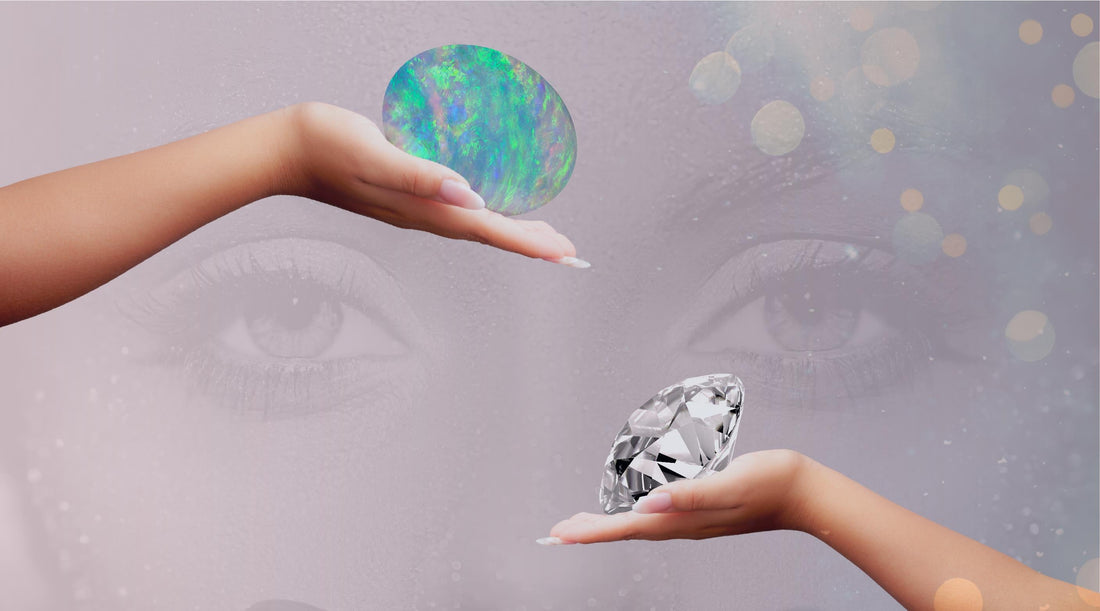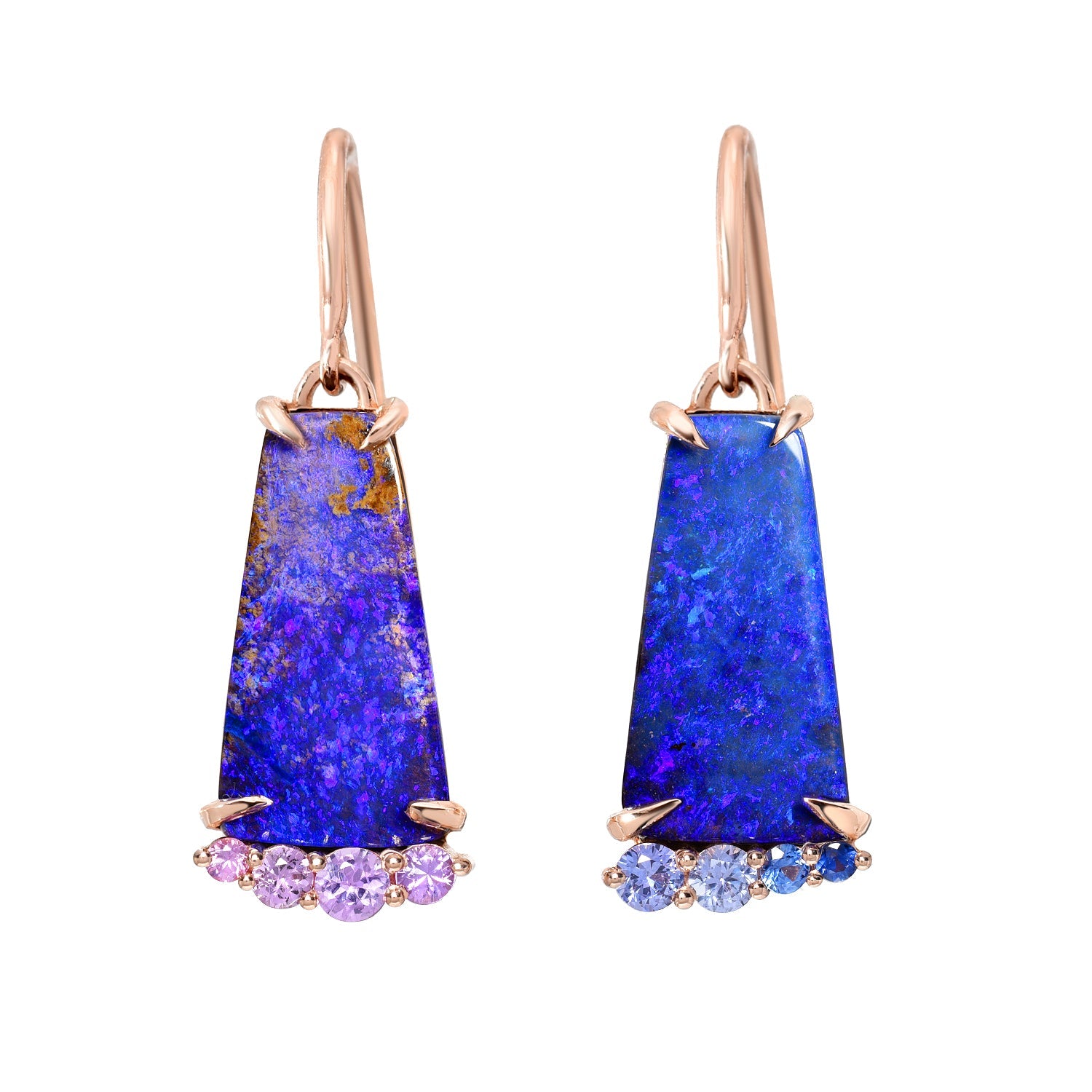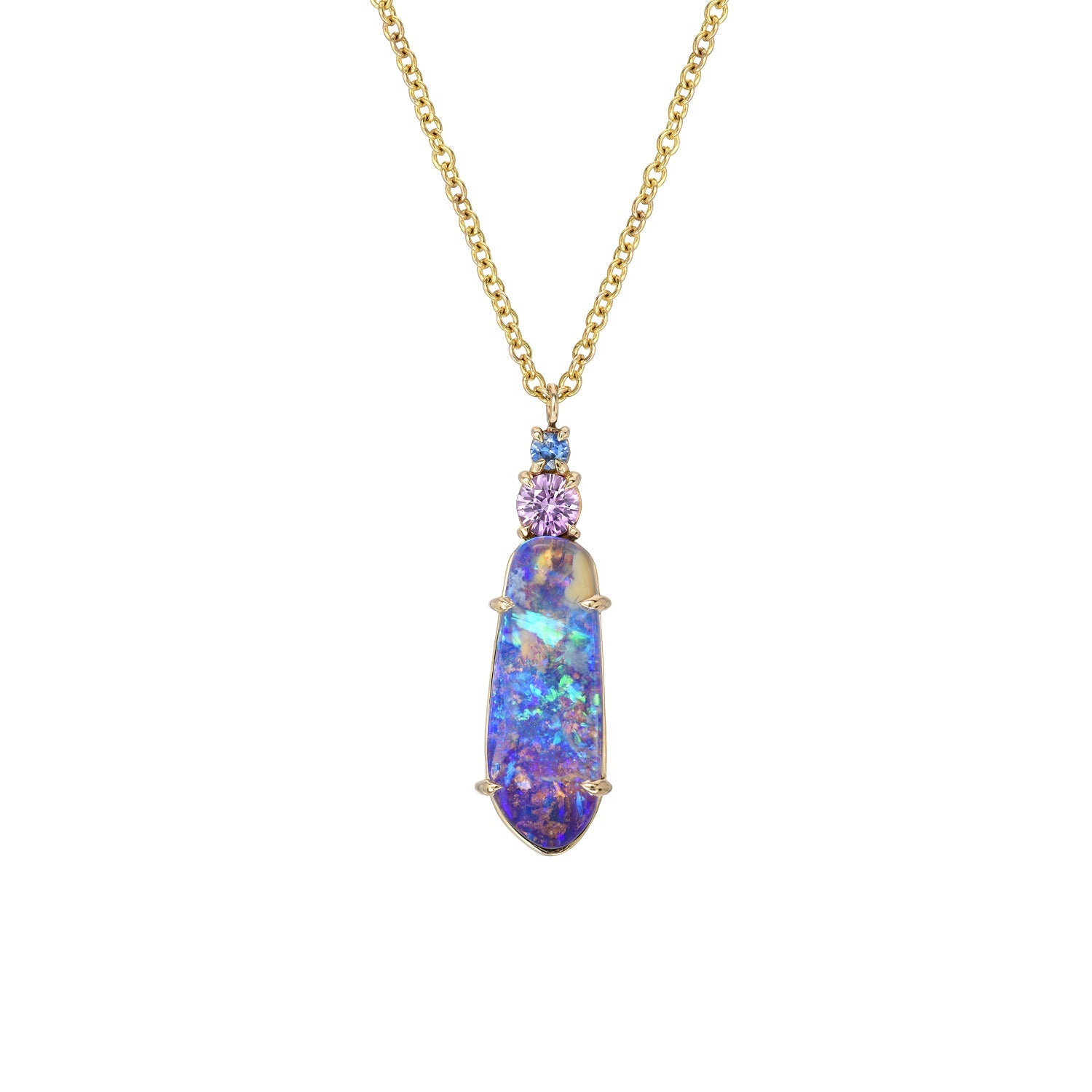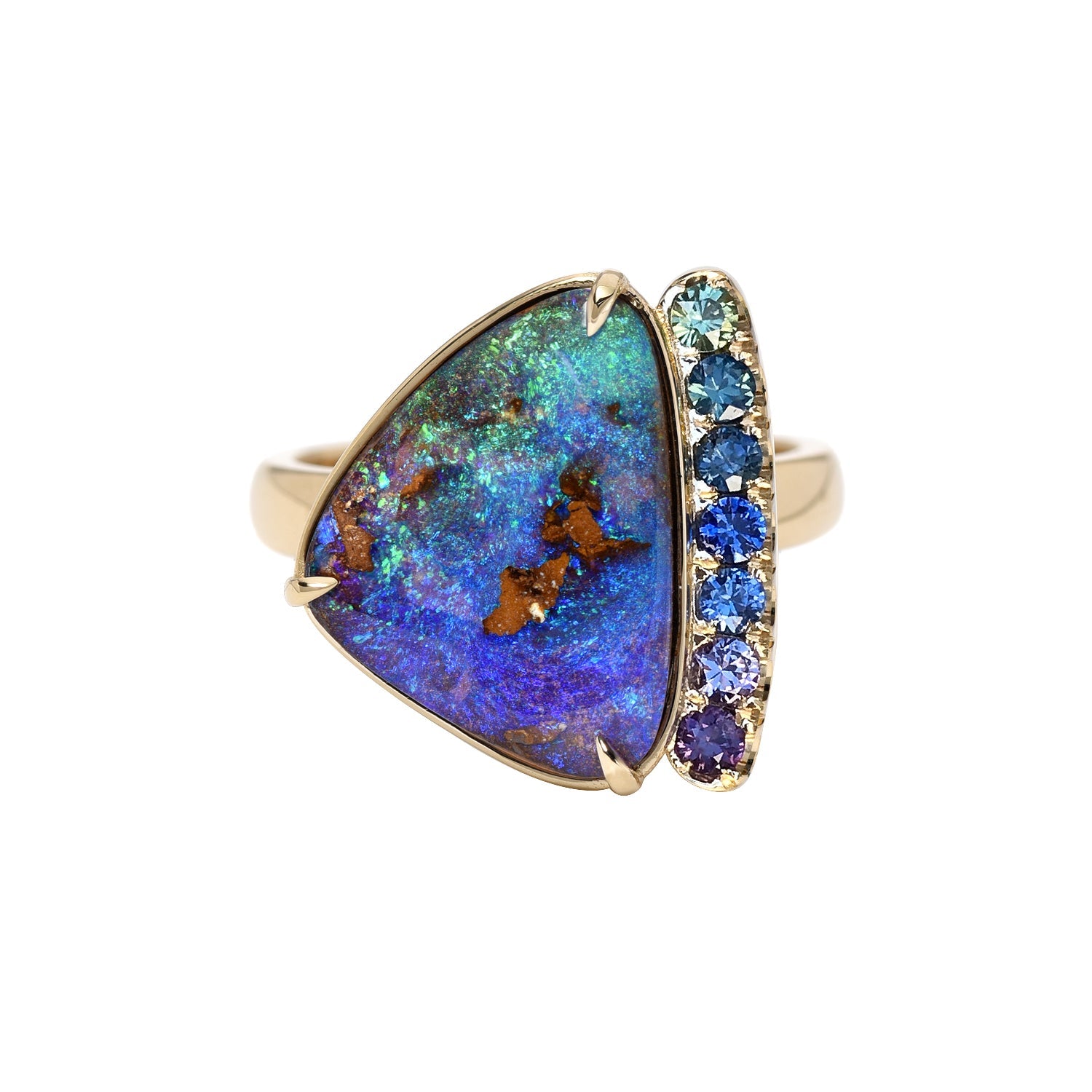
Opal and Diamond — which is really a girl's best friend?
luis gomezShare
In this article, we’re going to take a look at the differences between Opals and diamonds. What makes each of these gemstones unique and truly deserving of your hard-earned dollars. It may be a bit controversial, a bit subjective, a bit debatable but we're here to push the envelope and ask the hard questions — Opals Vs. Diamonds, which is better? Which gemstone should you invest in?
What are Opals?
Opals are gemstones. Or to be a bit more scientific in our answer, Opals are a hydrated amorphous form of silica. Though related to other forms of silica, such as agate and quartz, it differs in that it does not have a crystalline structure and its silicon dioxide composition may consist of up to 30% water. Because it is amorphous, Opal is classified as a mineraloid.
Opals are generally mined in the area of New South Wales in Australia. Over 95% of the world’s Opal stock comes from this region, including the Rolls Royce of the stone, the Black Opal.
A few other miscellaneous details about Opal one should be aware of:
- They are classified into three general categories: precious, common, and synthetic. If you want to know more about how Opals are categorized follow this link.
- They are the October birthstone.
- The stone is the traditional anniversary gemstone for the 14th year of marriage. (*and makes for a far less controversial anniversary gift than ivory.)
- They come in a broad range of colors.
- They can be found in other places, aside from Australia - in lesser quantities - including Mars.
What are Diamonds?
Diamonds are a solid form of carbon (or at least almost - some can have about .05% trace elements), with their atoms arranged in a crystal-like structure called a diamond cubic. And despite what you may have heard, they don’t actually develop from a lump of coal. Diamonds are shaped from carbon deposits by geothermic powers - heat, pressure, and the movement of tectonic plates. They have the highest level of thermal conductivity and hardness of any natural material. They are so hard, in fact, that the only natural substance that can scratch a diamond is another diamond. This very feature is one of the primary reasons they became the traditional way of representing an engagement; they, like true love, are revered as unbreakable. That said, diamonds aren't impervious to damage.
They are mined and sourced from around the world. Wherever there is volcanic activity it’s likely you’ll find diamonds too. The majority of diamonds come from South Africa, Canada, and Russia.
A few interesting details about diamonds to note:
- There are carbon-rich planets, out there in space (ie: exoplanet 55 Cancri e), that are predicted to be composed, largely, of diamonds.
- They take billions of years to make. They are nearly as old as Earth.
- Most diamonds that form about 100 miles below ground are in fact carried to the earth’s surface by geothermic eruptions.
- The first known diamond ring was discovered in Rome and dates back to the late 100s CE.

One of the first known diamond engagement rings, 1477
Diamonds Vs. Opals
The OG stone
The first diamond engagement ring ever recorded was noted in the will of an English widow in the late 1300s or early 1400s. But the first famous diamond engagement ring was a gold ring with an ‘M’ spelled out in diamonds. It was a gift for Mary of Burgundy, commissioned by Archduke Maximilian of Austria. It’s important to note the date, 1477, because up until then diamonds had not been customary when it came to fancy jewelry. Diamonds were mostly used for their “healing properties” - Middle Age superstition - as extra armor for battle, and as decorative adornments in devotional statues. For example, the Hindus regularly used diamonds as the eyes of their effigies in their temples.

Maximilian I of Austria and Mary of Burgundy
Most engagement rings, from before that era, were crafted out of gold with other gemstones embedded. The most coveted one? You guessed it! Opal. Why? Opals were, and continue to be, extremely rare. Back then, most people actually believed Opals were the stuff of asteroids and fallen space rock. That they had come to the planet in a celestial crash, and as such were touted as divine.
Opals were so coveted that in many cases wars were fought over them. Not only that, but they had a rather prestigious history attached to them. Marc Antony was said to have won over Cleopatra’s heart because he showered her with a gemstone they shared a fixation for — Opal.
Investment Opportunity
The truth is that getting your hands on a gem-quality Opal can be a challenge. Australian Black Opals are the most valuable, and a gem-quality one is even more rare and costly. Not only that, but unlike with diamonds that have a fairly straight-forward grading scale, valuing an Opal is somewhat more complex, given the vast nonconformity of the material, and the subjectivity tied to interpreting it. Although there are some general standards by which an Opal can be assessed, the bottom line for the consumer is that each Opal stone is truly one of a kind — so if you fall in love with the aesthetic appeal of one particular Opal, it’s highly unlikely you’ll ever find one that looks exactly the same.
Diamonds, on the other hand, can fetch a high market price irrespective of their quality (rustic diamonds have demonstrated this). That’s not to say they are all equal; just that even low-quality diamonds can be worth their weight in gold — sometimes quite literally. What we’re alluding to is that in the long run, diamonds may be a wiser investment opportunity than Opals. Why? They can give you liquidity faster. Selling a diamond to vendors that buy them, can be as easy as getting it appraised and weighing it. Opals, meanwhile, may take a little more work. If you want to know how Opals are valued, follow this link.
At the end of the day, however, you need to ask yourself why you’re buying either type of gemstone. If the goal is to flip the diamond or Opal ring or necklace, then yes, researching investment stones may be advisable. But if selling the piece is not your intention, then investment value may be of less concern. Most consumers in the market for these pieces are shopping for a piece to treasure; a diamond or Opal engagement ring to wear and enjoy, or maybe even to hand down as a future heirloom. If that is your end-goal, it may be more important to take into consideration which type of gemstone best suits you, your lifestyle, your aesthetic and your vision.
Opal Vs. Diamonds — Value Per Carat
There isn’t a great way to compare the value of Opals to diamonds, carat to carat, without having identified each stone’s unique characteristics. With diamonds, a slight scale shift up or down in carat weight or color (in any of the 4Cs), can translate into a difference of hundreds or even thousands upon thousands of dollars. Think of it like someone asking you if your car or their car is worth more…without telling you what types of cars each of you has, how old they are, what condition they’re in, etc… You get the idea. What’s important to understand is that both diamonds and opals are mined in greater quantities than is widely understood — but that very little of what is produced results in fine quality goods. That’s what deems both diamonds and Opals the reputation of being so rare…and aids each of these gemstones in fetching astronomical prices per carat (think $20k on up) for the most elusive and choice stones of them all.

Image courtesy of GIA
A flawless diamond, of the highest quality, can climb up to seven figures and even cost millions — the same for a superb, one-of-kind, Opal. The only difference is that jewelers, thanks to their graphs and metrics can tell you, objectively, that a diamond is flawless based on a universally accepted scale. The same cannot be said for an Opal, there is more subjective input when it comes to assessing its value.
Uniqueness
Compared to diamonds, precious Opals, gem quality, are far more unique and harder to mine. Sure you can find common Opals just about everywhere, but gem quality ones, like the ones sourced from Australia, are incredibly rare — not only that, they're extremely hard to mine properly and require a very gentle touch when crafting them into a piece of Australian Opal jewelry.
So, what should you buy? A diamond or an Opal?
Ultimately, it's all about personal preference. Comparing Opals to diamonds is like comparing apples to oranges, or Iron Man to Captain America. They both have their pros, their cons, and the only thing that binds them together, that makes them similar, is the fact that they are both types of gemstones. Apples and oranges both are a type of fruit. Iron Man and Captain America are both MCU heroes. And, diamonds and Opals are of course, both beautiful. But the similarities end there. The truth is that rubies, emeralds, diamonds, and Opals, each have their own respectable fanbase. It’s not really a competition, but rather an affinity for one or more of the precious gems that supersedes the others. If you’re thinking of investing in one, or another, say for an engagement ring, then honestly, you can’t go wrong — whichever one you pick.

Rainbow Trap Opal and Diamond Ring
Here at NIXIN Jewelry we *may* have a slight bias toward natural Opal jewelry, but truth be told, we adore a range of gemstones, diamonds included, and love finding ways to pair them together. Come explore what we have in store.



